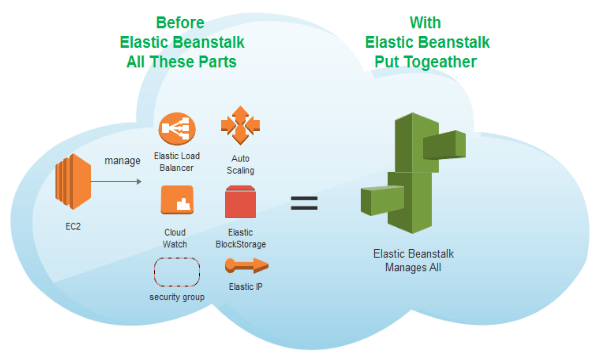AWS Elastic Beanstalk for Multi-Docker Container Applications
Amazon Web Services (AWS) Elastic Beanstalk is a Platform-as-a-Service (PaaS) solution that allows developers to deploy and manage applications in the AWS cloud without worrying about the infrastructure. While it supports various environments, including web servers and worker environments, Elastic Beanstalk is particularly effective for containerized applications. This article provides a comprehensive guide to deploying multi-container Docker applications using Elastic Beanstalk.
What is AWS Elastic Beanstalk?
AWS Elastic Beanstalk simplifies the deployment and scaling of web applications and services. Developers can upload their code, and Elastic Beanstalk automatically handles deployment, capacity provisioning, load balancing, auto-scaling, and application health monitoring.

Why Use Elastic Beanstalk for Docker Applications?
With the rise of containerization, Docker has become a popular choice for packaging and running applications. Elastic Beanstalk supports multi-container Docker environments, which makes it an ideal choice for applications requiring multiple services to run in isolated containers. Key benefits include:
Simplified management: No need to manually manage EC2 instances or Docker orchestration.
Integrated AWS ecosystem: Easy integration with other AWS services like RDS, S3, and CloudWatch.
Scalability: Automatic scaling to handle varying loads.
Prerequisites
Before deploying a multi-container application, ensure you have:
AWS Account: Sign up for an AWS account if you don’t already have one.
Docker Installed: Install Docker on your local machine.
Elastic Beanstalk CLI: Install the Elastic Beanstalk Command Line Interface (CLI).
Docker Compose File: A
docker-compose.ymlfile defining your multi-container setup.

Step-by-Step Guide to Deploy Multi-Docker Applications
1. Set Up Your Application
Prepare your application and ensure it runs locally using Docker Compose. Your docker-compose.yml file should specify all containers, networks, and volumes.

2. Install the Elastic Beanstalk CLI
Install the Elastic Beanstalk CLI to interact with Elastic Beanstalk from your terminal. Follow the AWS documentation for installation steps.
3. Initialize the Elastic Beanstalk Environment
Run the following command in your project directory:
eb init
During initialization:
Select your AWS region.
Choose the application platform (select Docker).
Set up SSH access for your EC2 instances (optional but recommended).
4. Create a Dockerrun.aws.json File
Elastic Beanstalk uses the Dockerrun.aws.json file to configure multi-container environments. Below is an example configuration:

5. Deploy Your Application
- Create an Elastic Beanstalk environment:
eb create my-env
2. **Deploy your application**:
```bash
eb deploy
Elastic Beanstalk will provision the required infrastructure, deploy your containers, and provide a URL for your application.
6. Monitor and Manage Your Application
Use the Elastic Beanstalk console to monitor application health and logs. You can also use the CLI:
eb status
eb logs
Integrating Additional AWS Services
Elastic Beanstalk seamlessly integrates with other AWS services:
Amazon RDS: For managed relational databases.
Amazon S3: For static file storage.
Amazon CloudWatch: For monitoring and logging.
For example, you can use RDS instead of running a database container for better scalability and durability.
Best Practices
Separate Stateful Services: Use AWS managed services (like RDS) for stateful components.
Use IAM Roles: Assign IAM roles to your Elastic Beanstalk environment for secure access to other AWS services.
Enable Auto-Scaling: Configure auto-scaling settings to handle traffic spikes efficiently.
Conclusion
AWS Elastic Beanstalk simplifies the deployment of multi-container Docker applications by abstracting the underlying infrastructure. It’s an excellent choice for developers looking to focus on application development rather than managing servers and scaling. By following the steps outlined in this guide, you can deploy and manage robust containerized applications in the AWS cloud.